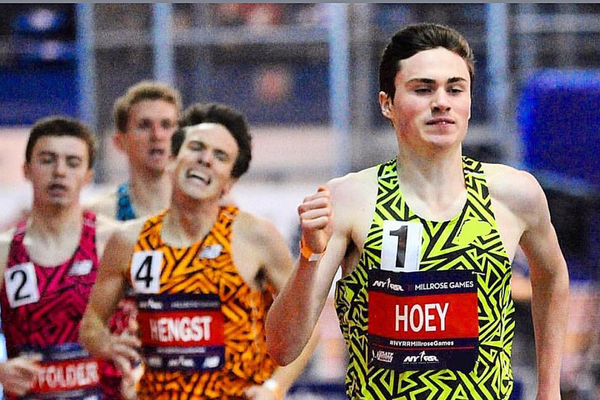
via Imago
Credit: Instagram/ Josh Hoey

via Imago
Credit: Instagram/ Josh Hoey
On May 14, American track fans got a jolt of excitement. A major name was added to the challengers’ group for the Philadelphia edition of Grand Slam Track. The athlete? A 25-year-old phenom who had just scorched through an undefeated indoor season, smashing American records in both the 800m (1:43.24) and 1000m (2:14.48) and clinching gold in the 800m at the World Indoor Championships. Even more fitting? He grew up just an hour west of Franklin Field. The return felt poetic — a homecoming with high stakes. Family and friends packed the stands. The buzz was undeniable. But then, he nearly walked away. Why?
When May 31 rolled around, the men’s 800m unfolded with fire. Marco Arop surged to victory. The hometown crowd erupted as Philly native Josh Hoey claimed second. And Yared ‘Goose’ Nuguse — the record-breaking sensation — finished third. Unexpected? Definitely. But the weekend still had more to give. Less than 24 hours later, Hoey was back on the track for the men’s 1500m. This time, he landed in fifth place. But by then, the result almost didn’t matter. Something bigger had already taken shape.
According to Jonathan Gault’s piece on LetsRun.com, Josh Hoey’s path wasn’t paved with easy decisions — it was built on bold ones. Such as? In 2023, with just one year left on his sponsorship deal with Adidas, Hoey had already begun preparing for life after the oval. He’d started interning at his father’s investment firm, considering a pivot toward a suit-and-tie future. After all, the track world hadn’t exactly been kind — he’d cycled through five coaches in five years, each one promising to unlock his full potential, each one eventually replaced. So Hoey made a choice that few professional athletes dare to: he fired the world — and hired himself.
ADVERTISEMENT
Article continues below this ad

No more strategy calls. No more half-truths or trial phases. If 2024 was to be his last season, he would do it on his terms. He would coach himself. That way, if he failed, there would be no one else to blame. And in true literary fashion, the self-coached athlete drew inspiration from his favorite playwright: Shakespeare. He even had a name in mind for the mission — Once More Track Club — an ode to King Henry V rallying his men before battle: Once more unto the breach, dear friends, once more; Or close the wall up with our English dead. And that one last effort paid beautifully for him.
In February, the Downingtown native broke through with his first personal best in four years—1:47.04 in the 800m at the U.S. Indoor Championships in Albuquerque, reaching the final. He placed third, just missing a spot at Worlds, but something was brewing. Next month, he dropped that time to 1:45.54 at the Pepsi Florida Relays. By April, he clocked a stunning 1500m PR of 3:38.63 at the Tom Jones Memorial. Momentum was on his side. By June, at the U.S. Olympic Trials, Hoey stormed through his semifinal with 1:45.73, then ran a brilliant 1:44.12 in the final — the fourth-fastest time ever recorded in a U.S. final. Though it wasn’t enough to book a ticket to Paris, it didn’t shake him. It fueled him. How?
In July, Josh crossed the Atlantic and dipped under the elusive 1:44 barrier—1:43.80 in Belgium. A career best. A world-class performance. It ranked him No. 21 globally by year’s end. Then came September, and with it, another breakout moment: 3:48.90 in the mile at the Fifth Avenue Mile, second only to Olympic silver medalist Josh Kerr. So, the man who almost walked away—who almost faded quietly—had instead roared his way back to the elite. And now?
What’s your perspective on:
From almost quitting to world-class: Does Josh Hoey's story redefine what it means to be resilient?
Have an interesting take?
Now, the track world already knows what 2025 has begun to look like. But somewhere in the middle of all this rising smoke and renewed glory, there was a subtle shift in the tale…A small, quiet detail most missed.
The track and field athlete hired a coach and went through changes
By 2023, Josh Hoey’s comeback wasn’t just a solo mission — it had quietly evolved into a carefully constructed campaign. And one of the most important reinforcements came from halfway across the world: Australian coach Justin Rinaldi.
Known for guiding Olympic medalist Peter Bol, Rinaldi brought a mindset that was more algorithm than adrenaline. His methods? Meticulous. Mathematical. He introduced a system of progression rooted in science, including finger-prick lactate testing during workouts to precisely measure physiological output. Every session was calculated. Every effort accounted for. “The main thing we are focused on with Josh,” Rinaldi told Citius Magazine in April 2024, “is actually pulling him back. He wants to do more, and sometimes you just have to do a little bit less.”
And therein lay the paradox of Josh Hoey — the self-coached athlete who wasn’t afraid to ask for help. The man, sprinting toward the future while grounded in reflection. Because it wasn’t just science fueling his fire. There was a spiritual side, too.
ADVERTISEMENT
Article continues below this ad
Throughout his resurgence, Hoey stayed connected with a “talking therapist” based in Germany — a voice of clarity and calm as the stakes rose. As the stopwatch counted down, someone had to make sure his soul stayed in step with his stride. In the end, his story wasn’t only about split times or lactate thresholds. It was — and still is — about harmony. Between ambition and restraint. Between effort and healing.

ADVERTISEMENT
Article continues below this ad
And unlike the final act of King Henry V, this tale isn’t wrapping up in some neat, heroic ending. No, Josh Hoey’s story is still surging forward — not with a curtain call, but with a quiet, powerful truth: The comeback isn’t just real — it’s far from finished.
ADVERTISEMENT
ADVERTISEMENT
ADVERTISEMENT
ADVERTISEMENT


From almost quitting to world-class: Does Josh Hoey's story redefine what it means to be resilient?